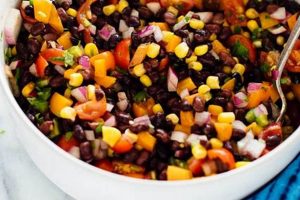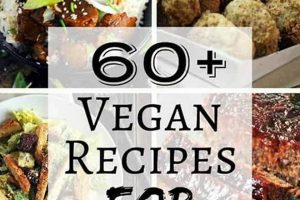A plant-based variation of a popular Greek street food involves substituting traditional meat fillings with ingredients like seitan, jackfruit, or mushrooms. This culinary adaptation maintains the essence of the original by incorporating flavorful spices and a creamy sauce, typically made from a vegan yogurt alternative. The outcome is a sandwich featuring warm, seasoned plant-based protein, fresh vegetables such as tomatoes and onions, and a tzatziki-style sauce, all wrapped in pita bread.
The increasing interest in meat-free diets has fueled the rise of these recipes. This food option allows individuals adhering to a vegan lifestyle to enjoy a familiar dish while aligning with their dietary choices. Furthermore, such meals can contribute to reduced consumption of animal products, potentially offering various health and environmental advantages. The evolution of this dish showcases the adaptability of global cuisine to accommodate diverse preferences and ethical considerations.
The following discussion will delve into the specific components, preparation techniques, and variations associated with crafting this popular meatless dish. We will explore the preparation of suitable meat substitutes, the creation of an authentic-tasting sauce, and techniques for assembling a satisfying and flavorful finished product.
Expert Guidance for a Plant-Based Gyro
Achieving optimal results in the preparation of a plant-based gyro requires attention to detail and strategic ingredient selection. These guidelines offer insights into key aspects of the cooking process.
Tip 1: Select High-Quality Plant-Based Protein: The success of this dish hinges on the texture and flavor of the chosen protein substitute. Opt for seitan, marinated jackfruit, or seasoned mushrooms known for their ability to mimic the savory profile of traditional meat.
Tip 2: Master the Marinade: A well-balanced marinade is crucial for infusing the protein with depth and complexity. Incorporate classic Greek spices like oregano, thyme, garlic, and lemon juice for an authentic flavor profile. Allow ample marinating time for maximum absorption.
Tip 3: Perfect the Searing Technique: High-heat searing is essential for achieving a desirable crust and texture on the plant-based protein. Avoid overcrowding the pan to ensure even browning and prevent steaming.
Tip 4: Emphasize Fresh, Complementary Vegetables: The quality of the vegetables significantly impacts the overall flavor. Utilize ripe tomatoes, crisp cucumbers, and thinly sliced red onions. Lightly dress the vegetables with olive oil, lemon juice, and a pinch of salt to enhance their natural flavors.
Tip 5: Craft an Authentic Tzatziki Alternative: The sauce is integral to the overall experience. Prepare a vegan tzatziki using a plant-based yogurt alternative. Incorporate grated cucumber, garlic, dill, and lemon juice for a refreshing and tangy accompaniment.
Tip 6: Warm the Pita Bread: Warmed pita bread provides a soft and pliable foundation for the dish. Briefly warm the pita on a dry skillet or in a toaster oven to enhance its texture and pliability.
Tip 7: Strategic Assembly is Key: Layer the components thoughtfully to ensure a balanced distribution of flavors and textures. Start with a generous layer of sauce, followed by the plant-based protein, vegetables, and a final drizzle of sauce.
Adhering to these suggestions will contribute to a more flavorful and satisfying rendition of this culinary creation. The judicious application of these principles will elevate the finished product.
The subsequent segments will explore the potential variations and customizations applicable to this recipe.
1. Protein Source Selection
The selection of the protein source is a pivotal determinant in the success of a plant-based gyro, influencing both its flavor profile and textural fidelity to the traditional meat-based version. This choice functions as the foundation upon which the other components are built. For instance, if one opts for seitan, a wheat gluten-based product, the resulting gyro often presents a chewy, meat-like texture amenable to high-heat cooking methods. The gluten-based nature allows for effective absorption of marinades, resulting in a richly flavored filling. Conversely, the use of jackfruit, particularly young, green jackfruit, necessitates a different approach. Jackfruit possesses a neutral flavor and stringy texture, requiring careful seasoning and slow cooking to emulate pulled meat. Incorrect selection, such as using tofu without proper pressing and marinating, can lead to a soggy and bland filling, fundamentally detracting from the intended gyro experience.
Furthermore, the chosen protein source directly impacts the nutritional composition. Seitan is high in protein but may not be suitable for individuals with gluten sensitivities. Jackfruit offers a lower protein content but contributes dietary fiber. Tofu presents a complete protein source but requires careful preparation to achieve a palatable texture. The decision should, therefore, consider both taste and dietary requirements. One can observe this interplay in commercial food products; many prepared vegan gyros utilize a blend of plant-based proteins to optimize both flavor and nutritional balance, demonstrating a practical application of this understanding.
In summary, careful consideration of the protein source is essential when preparing a meat-free gyro. This selection exerts a profound effect on the final product’s flavor, texture, and nutritional content. Recognizing the distinct characteristics of various protein alternatives and their corresponding preparation requirements enables the creation of a truly satisfying and authentic vegan gyro, mitigating the risk of undesirable outcomes. Therefore, the protein selection phase is a pivotal component to master when learning to make a plant-based gyro.
2. Marinade Composition
Marinade composition represents a critical factor determining the overall success of a vegan gyro recipe. The marinade serves to infuse the plant-based protein source with the savory and aromatic characteristics traditionally associated with gyro meat. Inadequate or improperly formulated marinades result in a bland or uncharacteristic final product, failing to replicate the desired sensory experience. The efficacy of the marinade is directly proportional to the palatability and authenticity of the meatless gyro; therefore, it necessitates careful consideration of ingredients and techniques.
The specific ingredients and their ratios within the marinade exert a significant influence on the resulting flavor profile. A typical marinade for a meat-free gyro often includes olive oil, lemon juice, garlic, oregano, thyme, and potentially smoked paprika or liquid smoke to impart a deeper savory note. The acid in the lemon juice aids in tenderizing the plant-based protein, while the olive oil serves as a carrier for the fat-soluble flavor compounds from the herbs and spices. The correct balance is essential; excessive acidity can result in an unpleasantly sour taste, while insufficient flavoring renders the protein bland. Consider the real-world example of seitan, a common protein alternative. Seitan benefits from a robust marinade due to its relatively neutral flavor. Conversely, marinated jackfruit, with its inherent subtle sweetness, may require a marinade with more savory and smoky elements to achieve a balanced flavor profile. The practical significance lies in understanding how the individual components of the marinade interact to create the desired taste.
In conclusion, the marinade composition plays a crucial role in dictating the quality and authenticity of a plant-based gyro. Mastering the art of marinade creation requires careful consideration of the protein source, the desired flavor profile, and the interactions between various ingredients. Challenges arise in achieving a balance that replicates the complex flavors of traditional gyro meat while remaining true to vegan principles. Recognizing the fundamental importance of the marinade connects directly to the wider objective of crafting a convincing and satisfying vegan alternative to a classic dish, highlighting the indispensable relationship between marinade composition and the success of the vegan gyro.
3. Sauce Authenticity
Sauce authenticity functions as a cornerstone of a successful plant-based gyro, contributing significantly to the overall taste experience. The sauce, typically a vegan adaptation of traditional tzatziki, must effectively replicate the flavor profile while adhering to dietary restrictions. Its composition and preparation directly impact the perceived authenticity of the entire dish.
- Plant-Based Yogurt Selection
The base of the sauce relies on a non-dairy yogurt alternative, influencing both texture and flavor. Options include soy, almond, cashew, or coconut-based yogurts, each possessing unique characteristics. Soy yogurt offers a neutral flavor closest to traditional dairy, while others may impart distinct nutty or tropical notes. The selection significantly affects the final taste profile, requiring adjustments to other ingredients to achieve balance. Inaccurate selection can result in an unpalatable flavor profile, diminishing the authenticity of the sauce.
- Cucumber Preparation
Cucumber, a primary component, requires careful preparation to avoid excess moisture in the sauce. Grated cucumber should be drained to remove excess liquid, preventing a watery consistency. Furthermore, the choice of cucumber variety impacts flavor. English cucumbers offer a milder taste with fewer seeds compared to standard varieties. Proper preparation is essential for maintaining the desired texture and preventing dilution of other flavors within the sauce, which might reduce the perceived authenticity.
- Flavor Balancing Agents
Garlic, dill, lemon juice, and olive oil constitute essential flavor components that require careful balancing. Garlic contributes pungency, while dill offers herbaceous notes. Lemon juice provides acidity, and olive oil adds richness. The ratios of these ingredients influence the overall taste, requiring precise adjustment to emulate the traditional flavor profile. An imbalance can lead to an overly acidic, pungent, or bland sauce, undermining the effort to create an authentic representation of tzatziki.
- Texture and Consistency
The final texture must mirror the creamy, slightly thick consistency of traditional tzatziki. This requires careful control of moisture content and potentially the addition of thickening agents such as cornstarch or tapioca starch. A sauce that is too thin or too thick fails to deliver the expected sensory experience. Correct texture is important to emulate a restaurant-quality vegan gyro, elevating the eating experience to achieve a sauce similar to that of traditional tzatziki sauce.
These elements converge to determine the authenticity of the sauce. Attention to the choice of plant-based yogurt, proper cucumber preparation, careful balancing of flavors, and precise control over texture is essential for achieving a convincing vegan tzatziki alternative. The result enhances the authenticity of a plant-based gyro by providing the desired taste and sensory experience, effectively mimicking the original dish while adhering to ethical and dietary considerations.
4. Vegetable Freshness
Vegetable freshness significantly influences the quality and overall success of a plant-based gyro. The crispness, flavor intensity, and nutritional value of the vegetables directly impact the final product. Substandard vegetables, characterized by wilting, discoloration, or diminished flavor, detract from the desired sensory experience. Conversely, the use of fresh, high-quality vegetables elevates the dish, contributing to a more satisfying and authentic culinary outcome. For example, using freshly sliced tomatoes, cucumbers, and onions provides a burst of flavor and a satisfying crunch that complements the savory plant-based protein and creamy sauce.
The impact of vegetable freshness extends beyond taste and texture. Fresh vegetables retain a higher concentration of vitamins, minerals, and antioxidants, contributing to the nutritional value of the gyro. Stale vegetables lose moisture and nutrients, resulting in a less nutritious dish. Furthermore, the visual appeal of the gyro is enhanced by the vibrant colors and textures of fresh vegetables. A wilted and unattractive vegetable component diminishes the overall presentation, influencing the consumer’s perception of quality and taste. Consider the example of a gyro assembled with freshly chopped parsley versus one with wilted, yellowing parsley; the former imparts a bright, herbaceous aroma and visual appeal, while the latter detracts from the eating experience.
In conclusion, vegetable freshness plays an integral role in the creation of a satisfying and authentic plant-based gyro. The selection and use of fresh, high-quality vegetables enhance the flavor, texture, nutritional value, and visual appeal of the dish. The practical significance of this understanding lies in the ability to create a superior product that delights the consumer and aligns with the principles of healthy, plant-based cuisine. Challenges associated with maintaining vegetable freshness, such as proper storage and sourcing, are worth addressing to ensure a consistently high-quality final product.
5. Pita Bread Quality
Pita bread quality directly influences the overall eating experience of a meat-free gyro. The bread serves not only as a vessel for the filling but also contributes significantly to the texture and flavor profile of the final product. Its integrity and characteristics are therefore paramount to achieving a satisfying result.
- Structural Integrity
Pita bread should possess sufficient structural integrity to contain the filling without tearing or becoming excessively soggy. A fragile pita compromises the eating experience, leading to ingredient spillage and diminished enjoyment. Examples include thicker pita varieties that can withstand moisture from the sauce and filling, while thinner, improperly baked pita may disintegrate rapidly. The structural element is foundational to the practicality and presentation of the gyro.
- Texture and Mouthfeel
The texture of the pita significantly impacts the overall mouthfeel. A soft, pliable pita complements the texture of the filling components. Conversely, a dry, brittle, or overly chewy pita detracts from the eating experience. Consider the contrast between a freshly baked pita, which offers a tender bite, and a stale pita, which may be tough and difficult to chew. This textural consideration is essential for sensory satisfaction.
- Flavor Profile
The flavor of the pita bread, while subtle, contributes to the overall taste profile. A bland or yeasty pita can detract from the flavors of the filling, while a slightly sweet or savory pita can enhance the other ingredients. For instance, some pita breads incorporate herbs or spices that complement the Mediterranean flavors of a traditional gyro. The flavour profile should contribute positively to the overall experience.
- Freshness and Storage
Pita bread should be fresh to ensure optimal texture and flavor. Stale pita becomes dry and brittle, negatively impacting the overall eating experience. Proper storage, such as sealing the pita in an airtight container, helps to maintain its freshness. The shelf life should be carefully taken into consideration to give a top-notch end result in every way.
The aforementioned aspects are intrinsically linked to the successful construction of a plant-based gyro. From holding the ingredients to lending its texture and taste, the pita bread is an indispensable piece of the dish. These points of discussion illustrate the importance of pita bread and how it should be picked out to deliver a top-notch result with every bite. Choosing an excellent choice of pita bread can elevate a vegan gyro into a food that can be regularly made.
Frequently Asked Questions
The following section addresses common inquiries regarding the creation of a meat-free gyro, providing clarity and practical guidance.
Question 1: What are suitable plant-based protein substitutes for a gyro?
Effective protein replacements include seitan, jackfruit, and marinated mushrooms. Seitan offers a meat-like texture, while jackfruit, when properly seasoned, mimics pulled meat. Mushrooms provide a savory flavor and tender consistency. The choice depends on desired texture and flavor profile.
Question 2: How can the marinade replicate the flavor of traditional gyro meat?
A successful marinade incorporates classic Greek spices such as oregano, thyme, garlic, and lemon juice. Adding smoked paprika or liquid smoke can impart a deeper savory note. The protein source should be marinated for a sufficient duration to allow for maximum flavor absorption.
Question 3: What are the key components of an authentic-tasting vegan tzatziki sauce?
An authentic vegan tzatziki sauce relies on a plant-based yogurt alternative, grated cucumber, garlic, dill, lemon juice, and olive oil. The cucumber should be drained to prevent a watery consistency. Precise balancing of flavors is crucial for replicating the traditional taste.
Question 4: How can the pita bread be prevented from becoming soggy?
To prevent sogginess, lightly warm the pita bread before assembling the gyro. Avoid overfilling the pita and ensure the cucumber in the tzatziki sauce is properly drained. Consider using a thicker pita variety that can withstand moisture.
Question 5: What vegetables best complement the plant-based protein in a gyro?
Classic vegetable components include ripe tomatoes, crisp cucumbers, and thinly sliced red onions. A light dressing of olive oil, lemon juice, and salt enhances their natural flavors. Freshness is essential for optimal taste and texture.
Question 6: Is it possible to prepare a plant-based gyro in advance?
The protein component and the tzatziki sauce can be prepared in advance and stored separately. However, assembling the gyro immediately before serving is recommended to maintain the freshness of the vegetables and the structural integrity of the pita bread.
In summary, successful meat-free gyro preparation hinges on careful ingredient selection, skillful marinade preparation, and attention to the individual components. Adherence to these principles will yield a satisfying and authentic culinary experience.
The subsequent discussion will address variations and creative adaptations of the plant-based gyro recipe.
Conclusion
This article has provided a comprehensive examination of the components and techniques involved in crafting a vegan gyro recipe. Emphasis has been placed on protein selection, marinade composition, sauce authenticity, vegetable freshness, and pita bread quality, all of which contribute to the final product. Each of these elements requires careful consideration to achieve a palatable and authentic culinary outcome that adheres to plant-based dietary guidelines.
The information presented serves to equip individuals with the knowledge necessary to create a satisfying and ethical alternative to the traditional gyro. Continued refinement of these techniques and experimentation with diverse plant-based ingredients will further enhance the potential of this culinary adaptation. By understanding the core principles outlined, practitioners can contribute to the evolution of plant-based cuisine and its increased accessibility to a wider audience.







